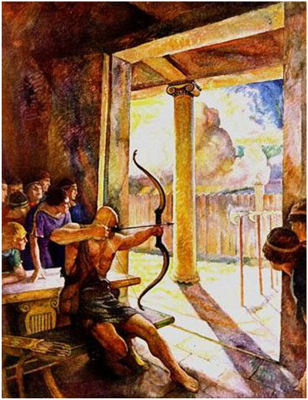The Philadelphia Museum of Art today announced a number of important gifts that will further enrich its world-renowned holdings. The new acquisitions include a major watercolor by Pierre Joseph Redouté, four masterworks of colonial Latin American art, a painting by N. C. Wyeth, a rare Tiffany chandelier, and more than two hundred works by the modern photographer Paul Strand.
Timothy Rub, the George D. Widener Director and CEO of the Museum, said: “Since its founding in 1876, more than 90 percent of the Museum’s treasured collection has come as gifts from generous donors, a remarkable group of philanthropists who have contributed to build one of the nation’s finest repositories of art and an exceptional resource for our community. We offer our deepest thanks to Roberta and Richard Huber, GlaxoSmithKline, Museum Trustee Lynne Honickman her husband Harold, their son Jeffrey Honickman and his wife Marjorie, Museum Trustee Ira Brind, and Elizabeth Shipley.”
The first painting to enter the collection by renowned illustrator N. C. Wyeth (American, 1882–1945) will be placed on view in gallery 124, adjacent to the Great Stair Hall, on March 5, 2013. Born in Massachusetts, Wyeth spent most of his life in Chadds Ford, Pennsylvania, where he raised five children, most notably his son the painter Andrew Wyeth. The Trial of the Bow is one of sixteen compositions made by Wyeth in 1929 to accompany George Herbert Palmer’s translation of The Odyssey of Homer. The painting depicts the moment when Ulysses, hiding incognito among Penelope’s suitors, reveals himself by firing an arrow from his own rigid bow, which had failed to yield to anyone else. The entire Odyssey series was sold by the artist to a private collector in 1930 and later scattered; most of the paintings remain unlocated. GlaxoSmithKline acquired The Trial of the Bow in the 1980s and placed the work on display at the global healthcare company’s Philadelphia office. Recently assessing its art collection as it prepared to move to new quarters, the company generously offered the painting as a gift to the Museum. Kathleen Foster, the Museum’s Robert L. McNeil, Jr., Senior Curator of American Art and Director, Center for American Art, examined the picture and determined that it was one of the “lost” Odyssey series, and a welcome addition to the collection.
A spectacular recent acquisition is Pierre Joseph Redouté’s Amaryllis Josephine. This double-page watercolor on vellum, accompanied by a pencil drawing of its bulb, was prepared for an ambitious series of engravings made under the patronage of the empress Joséphine, Napoleon Bonaparte’s wife. Praised as “the Raphael of Flowers,” Redouté (French, 1759–1840) had been Marie Antoinette’s official court artist before the empress employed him to record the rare blooms she collected for her gardens. This watercolor and drawing were given by Museum Trustee Ira Brind, in memory of Myrna Brind and in honor of David Brind, and will be shown in Philadelphia for the first time this summer in an upcoming exhibition of the Museum’s recent acquisitions.
Four gifts from Roberta and Richard Huber are eighteenth-century paintings: King Luis I of Spain on Horseback (Peru), Saint Anthony of Padua Preaching Before Pope Gregory IX (Peru), The House at Nazareth (Bolivia), and Our Lady of the Reedbed of Irún with Donor, Captain Joaquín Elorrieta by Ecuadorian artist José Cortés de Alcocer. These are among a larger number of works promised to the Museum by the couple, whose collection is featured in Journeys to New Worlds: Spanish and Portuguese Colonial Art from the Roberta and Richard Huber Collection, an exhibition now on view in the Museum’s Ruth and Raymond G. Perelman Building through May 19, 2013.
Two hundred thirty-six photographs by the pioneering modern photographer Paul Strand (American, 1890–1976) entered the collection at the end of 2012, including a large group of works given by Museum Trustee Lynne Honickman and her husband Harold, and another from their son Jeffrey Honickman and his wife Marjorie. Spanning the breadth of the artist’s career, these extraordinary gifts advance the Museum’s goal of completing a major acquisition of more than 4,000 Strand works from the Aperture Foundation that will make the Museum the world’s most important repository for the study of his work. A major retrospective exhibition devoted to Strand, the first in Philadelphia since 1971, will be presented at the Museum in fall 2014 and will travel internationally after its debut.
The colorful stained glass and bronze chandelier, made c. 1905 by Tiffany Studios under the artistic direction of Louis Comfort Tiffany (American, 1848–1933), is the gift of the Shipley family, descendents of the treasurer for the Board of Directors of Tiffany Studios from 1902–29. The Museum is rich in works by Tiffany, but this work’s classic twelve-sided leaded glass shade is the first of its kind in the collection. The chandelier will be included in the upcoming exhibition of the Museum’s recent acquisitions.
The Philadelphia Museum of Art is one of the largest museums in the United States, with a collection of more than 227,000 works of art. The Museum’s many galleries present painting, sculpture, works on paper, photography, decorative arts, textiles, and architectural settings from Asia, Europe, Latin America, and the United States. Its facilities include a landmark main building; the Ruth and Raymond G. Perelman Building; the Rodin Museum, and two historic houses in Fairmount Park, Mount Pleasant and Cedar Grove. The Museum offers a wide variety of activities for public audiences, including special exhibitions, programs for children and families, lectures, concerts, and films.




Comments